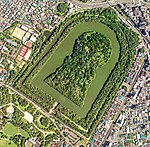Decorated kofun
Decorated kofun (装飾古墳, sōshoku kofun) is the term used for kofun or ancient Japanese tombs ornamented with painted or carved decoration. The tombs take the form of tumuli or earthen mounds piled over stone chambers as well as caves excavated from the living rock. The decoration may be on the inner walls, on stone screens, on sarcophagi or, in the case of cave tombs, around the entrance on the exterior. Of the 161,560 ancient burials identified to date, around two hundred and fifty are so decorated.[1][2][3][4][note 1]
Motifs[edit]
Decorative motifs include the chokkomon (an X-shape forming triangular zones that intersect irregular curves), circles, concentric circles, triangles, human figures, horses, birds, boats, swords, shields, and quivers.[5][note 2]
List of decorated kofun[edit]
This list is of the decorated kofun of ancient Japan, located in Fukuoka prefecture.[6][7][8]
| Image | Kofun | Municipality | Date | Tomb style | Decoration | Designation | Coordinates | Database | |
|---|---|---|---|---|---|---|---|---|---|
| Urayama Kofun浦山古墳Urayama kofun | Kurume | 450-500 | keyhole | incised (and red) concentric circles, chokkomon, kagitemon, triangles in a continuous pattern | Historic Site [1] | 33°17′06″N 130°32′09″E / 33.28486335°N 130.5357237°E | [2] | ||
| Nichirinji Kofun日輪寺古墳Nichirinji kofun | Kurume | 475-525 | keyhole | relief and incised (and red) concentric circles, chokkomon, kagitemon | Historic Site [3] | 33°19′14″N 130°29′54″E / 33.32046961°N 130.49845976°E | [4] | ||
| Yamanoshita Kofun山ノ下古墳Yamanoshita kofun | Kurume | round | red; indistinct | [8] | |||||
| Shimobaba Kofun下馬場古墳Shimobaba kofun | Kurume | 575-600 | round | red and blue concentric circles, triangles, and shields | Historic Site [5] | 33°18′50″N 130°37′22″E / 33.31383824°N 130.6227841°E | [6] | ||
| Tōkō-ji Kenzuka Kofun東光寺剣塚古墳Tōkō-ji Kenzuka kofun | Fukuoka | 525-575 | keyhole | incised boats | 33°34′26″N 130°25′58″E / 33.573849°N 130.432756°E | [7] | |||
| Sakurakyō Kofun 2桜京古墳 (2号古墳)Sakurakyō nigō kofun | Munakata | 550-600 | keyhole | red and green triangles, in a continuous pattern | Historic Site [8] | 33°50′38″N 130°29′43″E / 33.84389006°N 130.4953238°E | [9] | ||
| Haburakan Cave Tomb Cluster埴生羅漢山横穴墓群Haburakan yokoana bogun | Nakama | 575-650 | cave | incised boats | 33°48′57″N 130°41′55″E / 33.815845°N 130.698638°E | [10] | |||
| Seto Cave 14瀬戸14号横穴Seto jūyongō yokoana | Nakama | cave; replica at the Nakama City Museum of History and Folklore (中間市歴史民俗資料館) | red boats, human figures, horses, and birds | 33°49′04″N 130°41′59″E / 33.817841°N 130.699689°E | |||||
| Doinouchi Cave土居の内横穴Doinouchi yokoana | Nakama | cave | incised boats | 33°49′08″N 130°42′01″E / 33.818982°N 130.700269°E | |||||
| Furutsuki Cave Tomb Cluster (Cave 9)古月横穴墓群 (9号横穴)Furutsuki yokoana bogun | Kurate | 550-650 | cave | whitened and incised indistinct grid pattern | Historic Site [11] | 33°48′14″N 130°40′09″E / 33.80384288°N 130.66922356°E | [12] | ||

|
Takehara Kofun竹原古墳Takehara kofun | Miyawaka | 550-600 | round | black and red human figure, horse, dragon, fans, boat, waves | Historic Site [13] | 33°43′59″N 130°36′38″E / 33.73314575°N 130.61051484°E | [14] | |

|
Ōzuka Kofun王塚古墳Ōzuka kofun | Keisen | 525-575 | keyhole | red, green, yellow and black circles, concentric circles, triangles, birds, circular patterns with twin feet, vegetal motifs, quivers, bows, swords, shields, riders | Special Historic Site [15] | 33°35′19″N 130°39′49″E / 33.58873401°N 130.66359466°E | [16] | |
| Togami Kannonzuka Kofun砥上観音塚古墳Togami Kannonzuka kofun | Chikuzen | 575-600 | round | red circles, boats, riders | 33°28′52″N 130°36′23″E / 33.481102°N 130.606327°E | [17] | |||
| Kitsunezuka Kofun狐塚古墳Kitsunezuka kofun | Asakura | 600-625 | round | incised circles, concentric circles, boats, horses | 33°23′17″N 130°42′46″E / 33.388166°N 130.712832°E | [18] | |||
| Miyajidake Kofun宮地嶽古墳Miyajidake kofun | Asakura | round | red and blue circles | 33°23′55″N 130°43′42″E / 33.398736°N 130.728207°E | |||||

|
Gorōyama Kofun五郎山古墳Gorōyama kofun | Chikushino | 550-600 | round | red, black, and green quivers, bows, boats, houses, horses, birds, human figures, riders | Historic Site [19] | 33°27′07″N 130°32′43″E / 33.45192865°N 130.54520153°E | [20] | |

|
Haginoo Kofun萩ノ尾古墳Haginoo kofun | Ōmuta | c.600 | round | red and black; concentric circles, triangles, quivers, bows, boats | Historic Site [21] | 33°00′11″N 130°28′15″E / 33.00306°N 130.47083°E | [22] |
See also[edit]
Notes[edit]
- ^ "Japanese terms: tumuli (墳丘墓, funkyū-bo); cave tombs (横穴墓, yokoana-bo); wall painting (彩色壁画, saishiki hekiga); incised lines (線刻, senkoku); relief carving (浮彫, ukibori); sarcophagus (石棺, sekkan)
- ^ Japanese terms: chokkomon (直弧文, chokkomon); circles (円文, enmon); concentric circles (同心円文, dōshin-enmon); triangles (三角文, sankaku-mon); boats (船, fune); rings with feet (双脚輪状文, sōkyakurinjō-mon)
References[edit]
- ^ Kobayashi Yukio (1964). 装飾古墳 [Decorated Kofun] (in Japanese and English). Heibonsha. pp. 124–8.
- ^ Kidder, J. Edward (1964). Early Japanese Art: the Great Tombs and Treasures. Thames and Hudson. pp. 110–170, 272–324.
- ^ 兵庫県の遺跡・遺物数の全国的な位置 [Numeric Comparison of Historic Sites in Hyōgo Prefecture with National Totals] (PDF) (in Japanese). Hyōgo Prefecture. Retrieved 10 August 2013.
- ^ 装飾古墳データベース [Decorated Tomb Database] (in Japanese). Kyushu National Museum. Archived from the original on 16 August 2013. Retrieved 10 August 2013.
- ^ 文様 [Decorated Tomb Database: Motifs] (in Japanese). Kyushu National Museum. Archived from the original on 7 December 2009. Retrieved 10 August 2013.
- ^ Otomasu Shigetaka (1974). 装飾古墳の文様 [Decorated Kofun and their Motifs] (in Japanese). Kodansha. pp. 152–160.
- ^ 古墳一覧 [List of Kofun] (in Japanese). Kyushu National Museum. Archived from the original on 4 December 2013. Retrieved 12 August 2013.
- ^ a b National Museum of Japanese History, ed. (1993). 装飾古墳の世界 [Special Exhibition: Decorated Tombs in Japan] (in Japanese). Asahi Shimbun.
External links[edit]
- (in Japanese) Decorated Tomb Database

